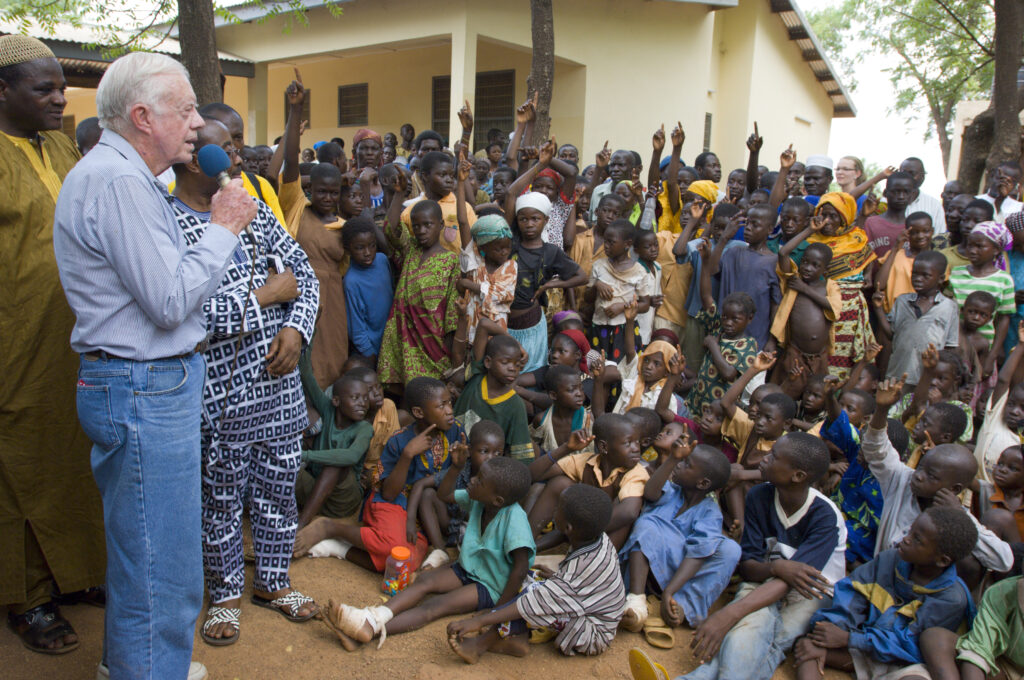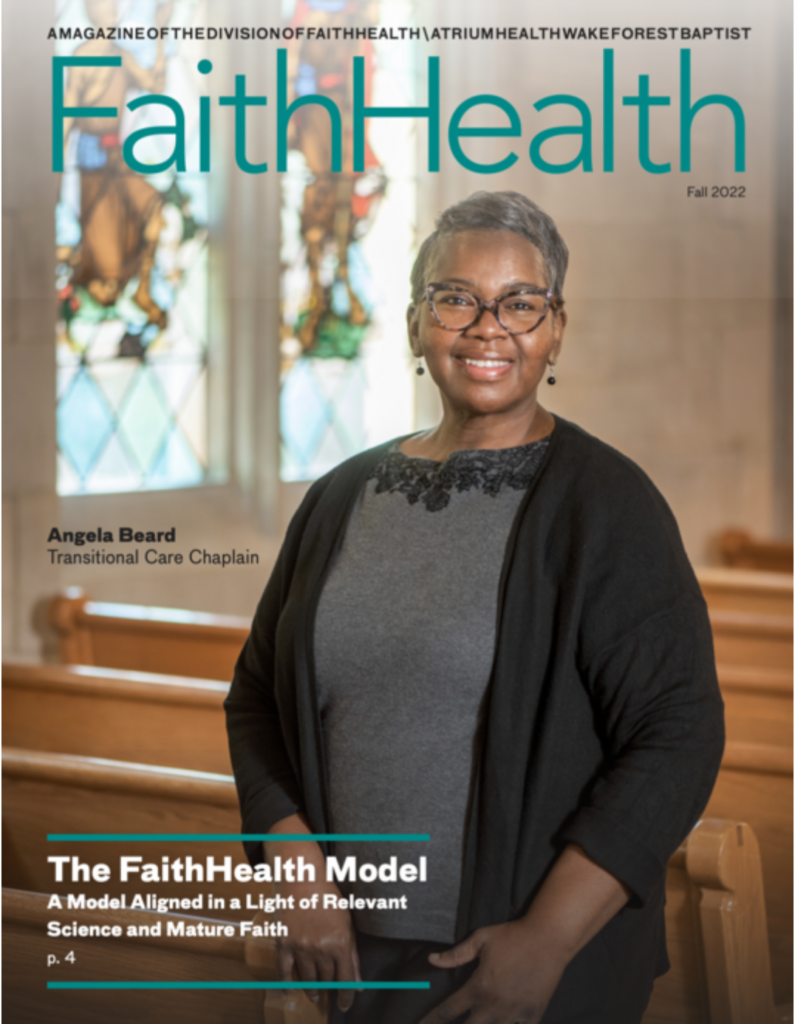
February 2007. Ghana. President Jimmy Carter and his wife Rosalynn address Savelugu children on the seriousness of eradicating guinea worm disease. In this Carter Center photo he has said “Hands up all those who have had Guinea Worm,” and many of the children put up their hands.
By Gary Gunderson
Jimmy Carter is not dead quite yet. Counting him out was almost never a good idea, whether he was running for an improbable office (every one he ever held) or an improbable health goal (guinea worm, polio, smoking or handgun violence). Or embracing improbable relationships—the Allman Brothers Band so key to the first steps of his race for President, Liberian pariah President Charles Taylor, or North Korean pariah President, Kim Jong-un.
Carter was able to live across improbable boundaries because he was comfortable with his own complexities and complicities; he knows he is human like all of the 8 billion of us. And he is clear-eyed about his own death, which most of us ignore until the last final shock.
Carter was always misread as being somewhat simplistic and moralistic. In fact, he worked through his own complexities to still chose to act, speak and do what he thought right. He was not surprised that his relationships sometimes made that harder; he was a loyal to people who made his life more complicated than a more ruthless man would have (thinking of a few bankers and entrepreneurs who clung to him like barnacles). A religious man with eclectic curiosity, he often confounded Baptist Christians who feared the grey areas (most of life). And he confounded secular friends who loved the grey so much they found it odd that a man could choose commitment and follow through.
Not satisfied with a simplistic stab at polio, he did the hard work decade after decade. Never satisfied with pontificating in a hotel ball room, he took African presidents to left-behind places they had never seen in their own countries. And then he went back again and again. He knew the complicated reasons for homelessness, but he never failed to pick up his own hammer and build one more home. He loved one woman his whole life, even though he was honest enough to almost lose an election by admitting “lust in his heart” for others. He gave the word “human” a good name.
Closing the Gap
Like many thousands, my life would be unrecognizably different had it not met his. Not long after he was involuntarily returned to civilian life from the White House, he started The Carter Center as a launching pad, more than a museum. Carter and Dr. Bill Foege, who had run the CDC during his administration, held the first global conference called Closing the Gap, even before he had a building. An engineer’s kind of conference, it asked how much of the burden of premature morality could be prevented based on what was already known. What could we actually do with what we already know? About two-thirds was preventable back in the 80’s, as your grandmother would have guessed. And who needs to act? Among others, the ubiquitous faith networks who he knew tended to sit around and wait for something terrible to happen and then act surprised at the most predictable things (cancer, war, diabetes, river blindness). Could religious people grasp the vast moral chasm causes by not acting on the patterns we know cause needless suffering? Carter and Foege got the attention of the Robert Wood Johnson Foundation and started the Interfaith Health Program, which I ended up leading. Why me, and not some famous academic bishop? Frankly, I’m not sure, but both men had a preference for action over formal qualifications.
The first thing we did was blow up the perfectly respectable grant plan of work, which began with a big formal conference at the new Carter Center. We replaced it with two years of scrappy meetings in dumpy basements and raggedy centers all over the nation (not unlike his run for president, now that I think of it). We asked the leaders actually doing things what they would commend to him as worth replicating. And we asked where they were stumped for lack of a clear vision of what might work. The two lists were identical, of course, which meant that the big innovation was having enough humility enough to realize that somebody down the road had probably already figured out the answer we thought we had to invent. It is actually harder to adapt something as it demands even more intelligence than simply plopping down another idea from somewhere. He called this a “mundane revolution.”
Carter is known for protecting the Arctic reaches of the Alaskan wilderness. I rafted the Canning River which borders that vastness and I was grateful. What other president even knew it was there, or would spend scarce political capital to protect it? It wasn’t just big nature he loved; he never missed participating in the Audubon bird count in Plains. He personally called the American Chestnut Society to get some hybrid seedlings to plant at The Carter Center, where they are improbably growing strong. He accepted some gift of koi from the Japanese government but refused to purify the pond so people could see them. (A Georgia pond is brown.) Life, even the mundane, is spectacular when you have eyes like his.
Choices that lead toward life
My very best ideas are tiny footnotes in the extraordinary legacy left by this special man. These include the “Memphis Model,” emulated by dozens of major healthcare systems all over the nation, the “religious health assets” which paved the way for the WHO into activating faith networks all over the world and, of course, Leading Causes of Life, which I spoke about the first time at a Conference in Milwaukee to which the former president sent me to in his place (imagine their disappointment!). Carter created a physical and a mental space where it seems reasonable to imagine things that had never happened and then try to do them. And then keep trying, maybe even for 98 years.
After decades of one unbearably oafish Christian after another desecrating the very idea of faith, he quietly gave his life as a long gift to his church and all people of faith: an example of sacred dignity and integrity. Not that the oafs understood. When he was gracious enough to invite evangelical leaders to the White House, more than one publicly prayed that he would become a better Christian. However, when my secular friends think that anyone who tries to believe is foolish, I could always say, “No, I mean people like Jimmy Carter.” They had to nod.
He had little patience with superficial piety. Once he had all of us directors reflect on whether Newt Gingrich had any good ideas in his “Contract with America.” I choked and noted this was not likely to go down well with the faith people who actually do the work on the streets. He snapped that the churches rarely break a sweat, while the government at least knows where all the poor live.
In the very first article for the Interfaith Health Program he wrote, “We must make the choices that lead toward life.” And who is accountable for those choices? Not just improbable presidents, but hundreds of thousands of improbable grown-ups doing the right thing when people notice and when they don’t.
This is true, even unto the very end of their days, when the right thing means releasing into the love of one’s family, instead of the normal vain and fruitless medicalized struggle against death. James Carter was proud, but never vain, often overlooked, but few lives bore so much fruit. I hope he lingers in hospice to savor the deep joy of a life well lived.
